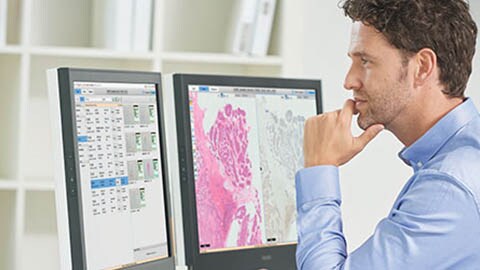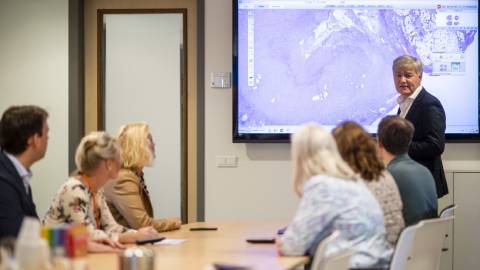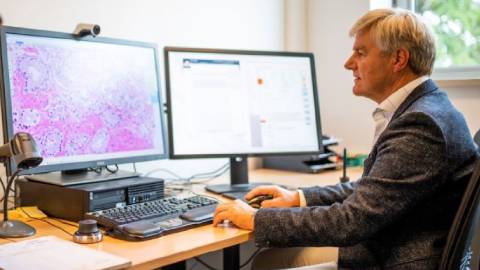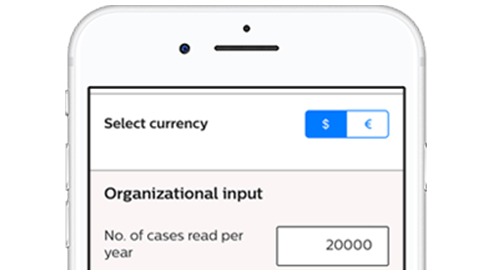Cancer cases are growing
With new cancer cases projected to rise nearly 70% within the next two decades, pathologists have to manage a steadily increasing workload.1
However, their workforce is diminishing, with AAMC reporting an 11.3% drop in the number of active pathologists between 2010 and 2015, and 63.2% of active pathologists expected to retire in the next decade.2
New cancer cases to rise nearly
70%
within the next two decades1
Digital pathology could help

Digitize your Workflow
to streamline the diagnostic process

Connect Your Team
to maximise your resources

Unify Patient Data
for informed decision making

Gain New Insights
to help your translate the ‘Big Data’ promise into knowledge
The need for digital pathology & computational pathology

18%

increase in productivity*
Digital Pathology increases productivity
Philips Digital & Computational Pathology aims to reduce the pressure on pathologists by streamlining workflow, sharpening diagnostic processes, facilitating partnership, and to enable collaboration regardless of location.
Digital pathology could have immediate implications for patient care as well: the digital workflow could eliminate issues with handling materials and could detect abnormalities as they occur. Digitization also means pathologists no longer have to worry about the risk of losing or damaging specimens.
The application of this technology could increase productivity by up to 18%3 because it eliminates time-consuming administrative tasks, reduces costs, and enhances lab performance.

Technology
Technology, both in the field of scanning and IT, has now finally met the necessary standards for digital pathology, in terms of software maturity and network, computing and storage capability.
Clinical pathology laboratories outside of the U.S. that have completed their transition to digital pathology include LabPON in The Netherlands, AZ St-Jan in Belgium, Hospitals Granada in Spain, Hall im Tirol and Innsbruck in Austria, IDEXX (globally) and Finn in the UK.
The Philips IntelliSite Pathology Solution4 is now allowed to be marketed for primary diagnostic interpretation and sign-out of digital pathology slides prepared for formalin-fixed paraffin embedded (FFPE) tissue.

Computational Pathology
Whereas digital pathology enables more efficient workflows, computational pathology will take the field one step further, allowing pathologists to use digital images in more varied and efficient ways. In the future, smart image recognition algorithms could help streamline pathologists’ workflows and help them to focus on the things that matter most.

Planning ahead
Making a good business case for digital pathology is all about planning ahead. Figure out what you want your digital laboratory to look like, what changes you need to make, and where you need to invest – and when you have the answers to those questions, you should be able to make a smooth transition and get a good return on your investment. In the long-term, digital pathology’s benefits outweigh its costs; it simplifies logistics, saves time, and allows pathologists to work more efficiently.

Logistics
The first main advantage to digital pathology is logistics. You don’t have to go through your physical archives anymore; you don’t need a secretary to manage your storage and filing systems; and you can save money by optimizing your staff and space requirements.
Published on Histopathology: 'Evaluating the benefits of digital pathology implementation: Time savings in laboratory logistics' - Alexi Baidoshvili, Anca Bucur, Jasper van Leeuwen, Jeroen van der Laak, Philip Kluin, Paul J van Diest.

15%

increase in productivity
recorded by LabPON
Diagnostic time
The second main advantage is diagnostic time. Digital diagnostics, including viewing slides digitally, is faster than the microscope. That means you increase both capacity and efficiency. On top of that, the quality of digital diagnostics is actually better than that of slide-based work.5,6
In a traditional laboratory, a glass slide is moved several times from the archive to the pathologist workstation and back. With digital slides, these unnecessary logistics are eliminated, the work becomes both faster and more convenient, and personnel can be allocated to other work. For instance, LabPON has seen an increase of 15% in productivity, without a substantial headcount reduction. Pathologists can do their diagnostics remotely from the hospital, or even from home.5,6
To enable the profession to harness the full potential of digitization, Philips have created the Digital Pathology Business Case Tool. Its algorithms map out the unique process flow analysis of a lab, and provide the means of presenting the strongest possible financial argument to the hospital board. The data combines Philips’ own evidence-based analysis with the independent experience of European labs already benefiting from digital workflow improvements.

Workflow-based tool
If a fully digital histopathology workflow is the solution, then labs need to understand the wider implications. It is not simply a means of streamlining slide assessment.
To enable the profession to harness the full potential of digitization, Philips have created a unique resource, the Digital Pathology Business Case Tool.
This workflow based, financial tool is designed to empower scientists and guide their business case discussions. Its robust algorithms provide the means of presenting the strongest possible financial argument to the hospital board. The data incorporates Philips’ own evidence-based analysis with the independent experience of European labs already benefiting from digital workflow improvements.
Crucially, the tool enables a lab to map out its own unique process flow analysis. It presents a core template which can be customized with data relevant to the specific challenges or specializations of a particular hospital.

Interested to find out the business case for going digital?

The breadth of detailed cost projections it provides includes process input and investment expenditure, ranging from the costs involving scanners and changes in IT infrastructure, to the provision of the algorithms that underpin the image analytics.
As part of quantifying workflow cost reductions for a post-digitization environment, it looks at the current cost of archiving, existing infrastructure for example microscopes and other renewals, maintenance, floor space, repeat work due to breakages, as well as the cost of the algorithms for image analytics.
Once the lab’s individual data is incorporated, the system creates two business cases for comparison. These project both a conservative approach alongside the potential benefits of a complete digital workflow implementation, over a five to seven year period. This is a complementary resource, with Philips also providing the service of its experts if labs need assistance in carrying out this information-gathering analysis.
Areas of interest

